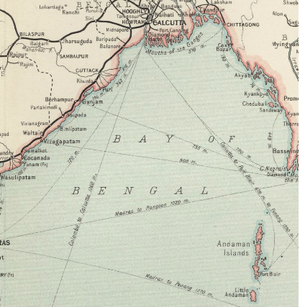Andaman Islands Timber Tramway
The Andaman Islands form an archipelago in the Bay of Bengal between India, to the west, and Myanmar (Burma), to the north and east [1].

Andaman Islands Timber Tramway
The ‘Andaman Islands Timber Tramway’ was a 2ft/610mm narrow gauge(NG) 'John Fowler' portable tramway was first used in 1890 when delivered with 1.5 miles(2.4km) of track. it was hand and/or bullock operated and by 1898 had 6.5 miles(10.4km) of track [2].
The system used was laid on steel sleepers to which the rail was bolted and the sections could be carried by 2 men and construction could be made by people with no specific skills in railway construction. A description of the forest tramway in a report by Mr Dingwall in 1895 and again by Mr Buchanan in 1897 was published [3]:-
The reports stated that the gauge was 2 feet on 18lb rails on steel sleepers and was suitable for animal or manual operation. The initial line was laid along Dhaini Khari creek at the side of the existing road. Elephants had up to then been used to drag the timber out of the forest. Keeping and transporting elephants was proving expensive hence the need for a tramway. The equipment with 1.5 miles of track arrived late in 1890 and by the 10t Jan 1891 was in use. It was extended another mile later in the year and in 1893 extended 2 miles more. 12 trucks and 2 trolleys were in use.
Experience showed that it was usable for 3 years and worked by manual labour and buffalo and was more profitable than using elephants and that there was plenty of timber to feed the line.
The tramway was capable of moving 3 to 5 tons logs. The line was laid with sidings every 1 to 2 miles (1.6 to 3.2km) Men and Buffalo were used. 4 men were used to operate 1 truck including the loading and unloading. The trucks travelled at 2 mph. (3.2kph) and travelled 6-7 miles (9 to 11 km) and returned in the evening.
Wimberleyganj Steam Tramway and expansion

From 1900 a new 2ft/610mm narrow gauge(NG) system was laid [3]
- ‘Wimberleyganj to Shoal Bay Creek’, 7 miles(11km) operated by steam locomotives and firewood trucks. The system was expanded and by 1907 other lines added [2] :-
- 'Brickfields to South Quarries and firewood area', 5 miles(8km);
- 'North Bay to North Quarries', 2 miles(3.2km);
- 'Bajajag to Constance Bay and Port Moat', 6 miles(9.6km)
- plus other short lines as required.
Wimberleyganj and Bajajog are shown on map[3]
In 1914 the Forest Department reported that the stock comprised two locomotives and wagons.
From 1917 other hand worked lines were opened in forests and the track came from the Steam Tramway [2].
Later Tramway
It appears likely that at some point a 2ft 6in/762mm narrow gauge(NG) was adopted
Confirmation of this is required.
The system continued to be in operation post 1947 [2].
References
- ↑ Wikipedia ‘Andaman Islands’; Retrieved 29 May 2020
- ↑ 2.0 2.1 2.2 2.3 “Industrial Railways and Locomotives of India and South Asia” compliled by Simon Darvill. Published by ‘The Industrial Railway Society’ 2013. ISBN 978 1 901556 82-7. Available at http://irsshop.co.uk/India. Reference: Entry AN02 pages 59-60
- ↑ 3.0 3.1 3.2 ‘A manual of Forest Engineering for India’ Vol 3 Government of India 1902. Appendix 2; Retrieved 29 May 2020